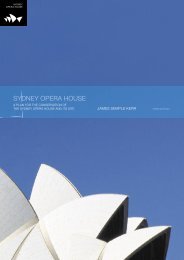nomination by the Government of Australia - Sydney Opera House
nomination by the Government of Australia - Sydney Opera House
nomination by the Government of Australia - Sydney Opera House
Create successful ePaper yourself
Turn your PDF publications into a flip-book with our unique Google optimized e-Paper software.
3.43<br />
also inspired <strong>by</strong> <strong>the</strong> laws <strong>of</strong> nature—‘my laboratory<br />
is <strong>the</strong> beach, <strong>the</strong> forest, <strong>the</strong> sea and <strong>the</strong> seashore’<br />
(Weston 2002: 278). But in abiding <strong>by</strong> <strong>the</strong>se laws, Utzon<br />
found room for a poetry and lyricism that is missing in<br />
some <strong>of</strong> Nervi’s Exhibition Buildings. Utzon and engineer<br />
Ove Arup matched Nervi’s innovations with quantum<br />
leaps in engineering science, <strong>the</strong> design and erection<br />
<strong>of</strong> prestressed concrete and <strong>the</strong> precision <strong>of</strong> precasting<br />
and formworking made possible through an innovative<br />
use <strong>of</strong> new computer technologies.<br />
In comparing <strong>the</strong> <strong>Sydney</strong> <strong>Opera</strong> <strong>House</strong> with Saarinen’s<br />
TWA Terminal it is clear that <strong>the</strong> buildings share<br />
some common origins in terms <strong>of</strong> <strong>the</strong> combinations<br />
<strong>of</strong> architectonics and structural engineering and<br />
similarity <strong>of</strong> ro<strong>of</strong> shapes. Both represented outstanding<br />
architectural design and engineering achievements.<br />
Saarinen took in situ concrete construction to its<br />
practical limit in <strong>the</strong> TWA Terminal, using <strong>the</strong> curvature<br />
<strong>of</strong> <strong>the</strong> thin ro<strong>of</strong> covering to provide both span and<br />
rigidity. The <strong>the</strong>me <strong>of</strong> futuristic motion extends to all<br />
parts <strong>of</strong> <strong>the</strong> building including metaphorical ‘feet’ where<br />
<strong>the</strong> wings come down to earth. Necessary movement<br />
joints between <strong>the</strong> shells become shafts where natural<br />
light is brought deep into <strong>the</strong> building. Saarinen stated<br />
that it was a ‘fully designed environment in which each<br />
part arises from ano<strong>the</strong>r’ (The Great Buildings Collection<br />
web site 2005). Sharp has noted that Saarinen’s<br />
evocative building at <strong>the</strong> gateway to <strong>the</strong> United States<br />
‘alarmed <strong>the</strong> remaining purists <strong>of</strong> modern architecture’<br />
(The Great Buildings Collection web site 2005).<br />
Figure 3.43 Eero Saarinen’s TWA Terminal, Kennedy<br />
Airport, New York, 1956–1962<br />
The TWA Terminal is without doubt a dramatic building,<br />
particularly for people moving within its sinuous<br />
concrete shells. Its free-form plasticity is exceptional<br />
and not unlike Saarinen’s well-known ‘tulip’ chairs<br />
and fi breglass tables. Saarinen’s amazing building<br />
achievement is evoked <strong>by</strong> <strong>the</strong> many references to its<br />
‘soaring spaces’ and ‘birds in fl ight’.<br />
The <strong>Sydney</strong> <strong>Opera</strong> <strong>House</strong> bears important similarities to<br />
<strong>the</strong> buildings <strong>of</strong> Nervi and Saarinen. It is a dramatically<br />
strong work in terms <strong>of</strong> its siting within <strong>the</strong> landscape,<br />
its structural design and construction and its complex<br />
architectural meaning even in comparison to <strong>the</strong><br />
buildings <strong>of</strong> Nervi and Saarinen discussed above. All <strong>the</strong><br />
buildings share amazing technological feats in <strong>the</strong> use<br />
<strong>of</strong> large clear spans and <strong>the</strong> extensive use <strong>of</strong> concrete.<br />
But <strong>the</strong> functional simplicity <strong>of</strong> <strong>the</strong> Nervi and Saarinen<br />
ro<strong>of</strong>s serves to highlight <strong>the</strong> complex structural and<br />
architectural expression <strong>of</strong> <strong>the</strong> ro<strong>of</strong>s <strong>of</strong> <strong>the</strong> <strong>Sydney</strong><br />
<strong>Opera</strong> <strong>House</strong>. For Utzon, designing and building <strong>the</strong><br />
shell ro<strong>of</strong>s was only <strong>the</strong> start <strong>of</strong> <strong>the</strong> adventure.<br />
As Carter has noted, <strong>the</strong> use <strong>of</strong> differing glazes for <strong>the</strong><br />
ro<strong>of</strong> tiles gave Utzon <strong>the</strong> ‘combination <strong>of</strong> matt snow<br />
and shining ice’ he was looking for and resulted in one<br />
<strong>of</strong> <strong>the</strong> ‘most radiant and alive surfaces in architecture,<br />
thoroughly modern in its abstraction and technically<br />
impossible before its day’ (Sharp 2005; Whittick 1980:<br />
589; Carter 2005).<br />
51

















